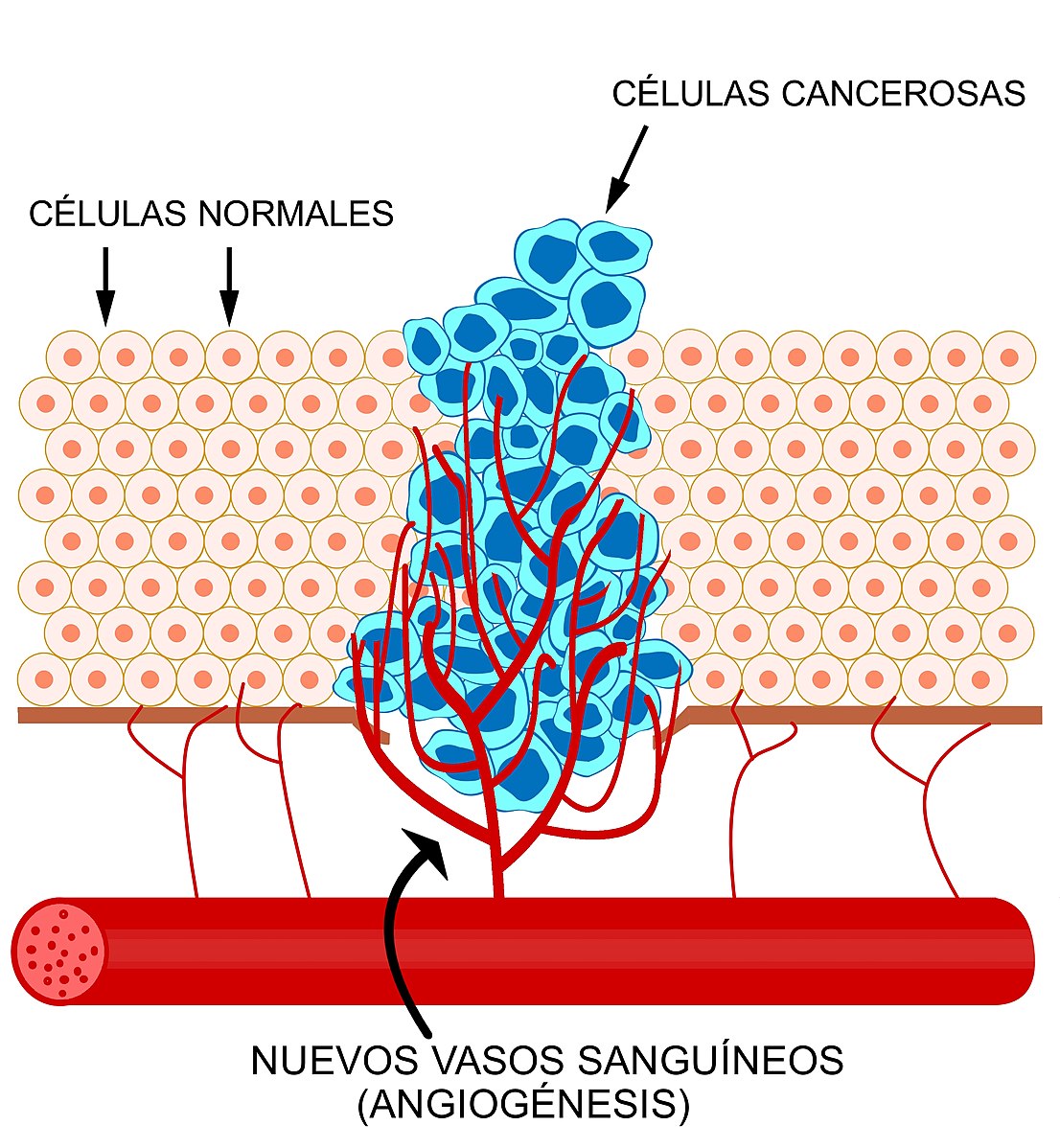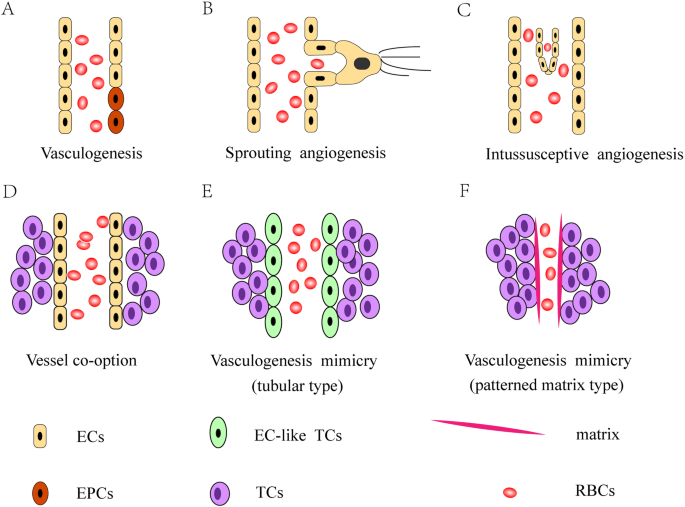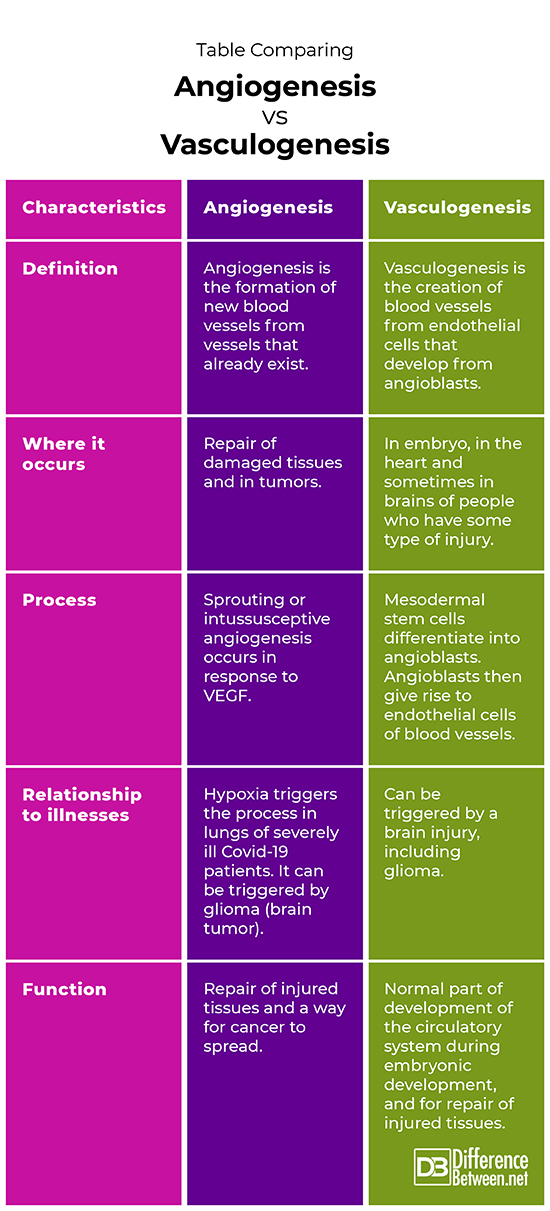Difference Between Angiogenesis and Vasculogenesis
Angiogenesis is the process in which new blood vessels develop from pre-existing blood vessels. Vasculogenesis is the formation of new blood vessels from angioblasts and endothelial cells.

What is Angiogenesis?
Definition:
Angiogenesis is when new blood vessels form from blood vessels that already exist in the body.
Reasons for angiogenesis:
Angiogenesis can take place when tissues are damaged and a new blood supply is needed but develops from vessels that are already present. Another time that angiogenesis can occur is when tumors develop. In some cases, tumors use growth factors and are able to develop a blood supply, leading to the particular cancer becoming malignant.
Process:
Tumors use vascular endothelial growth factor (VEGF) to form blood vessels. The VEFG is secreted from tissues that are suffering from low oxygen due to damage. In the case of tumors, though, tissue does not need to be damaged for the VEGF to be produced and angiogenesis to be triggered. Angiogenesis can occur by two processes: intussusceptive or sprouting angiogenesis. Intussusceptive is when angiogenesis occurs by a blood vessel splitting into more than one branch. Sprouting angiogenesis is when cells grow in the direction of the stimulus such as VEFG. Other growth factors such as fibroblast growth factor also affect angiogenesis.

What is Vasculogenesis?
Definition:
Vasculogenesis is the process in which cells called angioblasts develop and differentiate into endothelial cells that will eventually develop into blood vessels.
Reasons for vasculogenesis:
This is a part of embryonic development that allows blood vessels to be formed, and it occurs in some organs such as the heart and brain.
Process:
Vasculogenesis in embryo development occurs from angioblasts which are cells that originate from stem cells of the mesoderm tissue. The process is triggered by fibroblast growth factor (FGF) that acts a signal for tissue development and repair. The receptor tyrosine kinase flk-1 along with vascular endothelial growth factor, also play a role in blood vessel development during the gastrula stage of embryo development.
Difference between Angiogenesis and Vasculogenesis
Definition
Angiogenesis is the formation of new blood vessels from blood vessels that already exist. Vasculogenesis is the creation of blood vessels from endothelial cells that develop from angioblasts.
Where it occurs
Angiogenesis is a process that occurs on some types of tumors and in response to damaged tissues as a way to repair the tissues. Vasculogenesis takes place during embryonic development and in people who have injuries to the heart and brain tissue.
Process
In the case of angiogenesis, sprouting or intussusceptive angiogenesis occurs in response to VEGF. In the case of vasculogenesis, mesodermal stem cells give rise to angioblasts that then develop into endothelial cells of blood vessels.
Relationship to illnesses
Hypoxia (low oxygen levels) triggers angiogenesis to take place in the lungs of severely ill Covid-19 patients. It can also be triggered by the presence of a glioma (brain tumor). A brain injury, including also the presence of a glioma, can trigger vasculogenesis.
Function
The function of angiogenesis is the repair of injured tissues and it is also a way for cancer cells to spread from an initial tumor site. The function of vasculogenesis is embryonic development of the circulatory system and also repair of injured brain or heart tissues.
Table comparing Angiogenesis and Vasculogenesis

Summary of Angiogenesis Vs. Vasculogenesis
- Angiogenesis is development of blood vessels from vessels that are already present in the body.
- Vasculogenesis is when blood vessels develop from angioblast cells that arose from the mesoderm originally.
- Both angiogenesis and vasculogenesis are processes that lead to increased blood vessel formation in the body.
- In both vasculogenesis and angiogenesis, proteins called growth factors are important in stimulating the blood vessel formation.
FAQ
Is angiogenesis a vascularization?
It is linked to vascularization only in the sense that it arises from already formed blood vessels, but unlike vascularization it forms from other vessels and not angioblasts.
What is vasculogenesis mechanism?
Endothelial cells form from angioblasts, which in turn originally developed from stem cells of the mesoderm layer. The endothelial cells form some of the tissue in blood vessels.
What is metastasis and angiogenesis?
Metastasis is the spread of cancer cells through the blood and lymph. Angiogenesis is the creation of more blood vessels from pre-existing vasculature, which can in the case of a tumor then lead to metastasis of cancer.
What causes Vasculogenesis?
Vasculogenesis is a normal part of embryo development that takes place in the gastrula stage, but it is also triggered by a lack of oxygen when tissues are damaged in the body.
Why is angiogenesis bad?
Angiogenesis is harmful when it occurs on tumors since it then enables cancer cells to disperse throughout the body once a blood supply is present. The spread of cancer is metastasis and then makes treating the illness difficult.
Does angiogenesis increase resistance?
Angiogenesis does lead to increased resistance because it adds length to the vasculature.
- Difference Between Rumination and Regurgitation - June 13, 2024
- Difference Between Pyelectasis and Hydronephrosis - June 4, 2024
- Difference Between Cellulitis and Erysipelas - June 1, 2024
Search DifferenceBetween.net :
References :
[0]Adair, Thomas H., and Jean-Pierre Montani. "Angiogenesis." Colloquium series on integrated systems physiology: from molecule to function. Vol. 2. No. 1. Morgan & Claypool Life Sciences, 2010.
[1]Encyclopedia Britannica. “Angiogenesis”. Encyclopedia Britannica, 2021, https://www.britannica.com/science/angiogenesis
[2]Risau, Werner, and Ingo Flamme. "Vasculogenesis." Annual review of cell and developmental biology 11.1 (1995): 73-91.
[3]Image credit: https://media.springernature.com/lw685/springer-static/image/art%3A10.1186%2Fs13045-020-00858-6/MediaObjects/13045_2020_858_Fig1_HTML.png
[4]Image credit: https://commons.wikimedia.org/wiki/File:Angiogenesis.jpg
